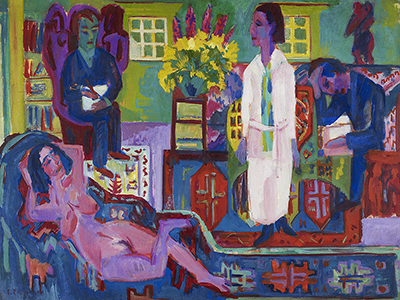Kirchner put together Modern Bohemia in 1924 and it is now a part of the collection of the Minneapolis Institute of Art having been bequethed to them by the previous owner, Curt Valentin.
This scene captures the artist's home in Switzerland, and outlines his impression of what environment would be best for creative people to live within. The expressive style used by the artist means we have to concentrate in order to pick out the different elements of the scene, though those familiar with his career will already been tuned into his style of depicting figures and objects. The complexity of this composition combined with horizontal and vertical lines led some to compare this style to tapestry and this period in his career was termed as such. One model reclines in the bottom left of the painting, whilst another wears a robe, clearly preparing to do the same shortly.
To their side are two artists who are busily sketching their forms, concentrating intently on their work. A complex series of carpets and rugs can be found around the scene as well as several comfortable sofas. There are some flowers in a vase placed centrally which again builds a feeling of cosy comfort. Two small windows sit behind, along with a small series of shelves which contain a mixture of unorganised reading materials. We might assume that some of these would refer to elements of art history in order to inspire the minds of these keen creative people. The colour scheme is distinctly restrained, with purples, greens and reddish browns making up the majority of the painting. These colours continue into many other paintings by this artist.
An interesting aspect to this painting is that it is just one of a series of artworks that Kirchner created along this theme. There were drawings and woodcuts which depict the same lounge, but from different angles and with different arrangements of the furniture and figures. MoMA owns several of these lesser known pieces and the series together provides a helpful look into the mind of the artist's processes. Kirchner was a driven artist who was always experimenting with different art forms, and this painting helps us to get an idea of how he would have gone about working from home.




